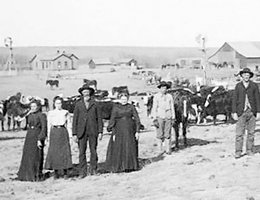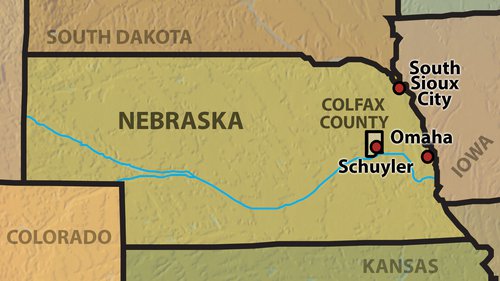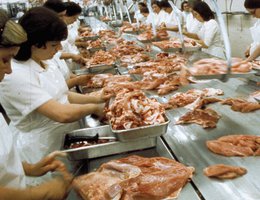

The story of beef is the story of a migration from south to north. Cattle came to North America with the Spanish in 1493. The large herds that roamed the Texas plains descended from the Spanish cattle, and many of those cowboys who pushed cattle into Nebraska in the 1870s were Mexican. Between 1900 and 1929, large numbers of Mexicans came to Nebraska. They left their home country because of political and economic problems. They found jobs in the beet fields of western Nebraska as well as the stockyards and packing houses, mostly in South Omaha.
In the 1990s, Nebraska saw enormous growth in the number of Hispanics (mostly Mexicans, Guatemalans, and Salvadorans). The term Hispanic refers to anyone who speaks Spanish as his or her original language, or is descended from someone who did. Hispanics could be American-born or from many different Spanish-speaking countries all over the world. These Hispanics were looking for jobs. The packing houses, which had moved into smaller Nebraska communities, created a large number of jobs that needed little skill and paid fairly low wages. But the low wages were very attractive to immigrants who could make more in an hour here than they would make in a day back home.

Several communities across the state, including Lexington, Madison, Grand Island, and Schuyler, saw their populations swell. In Lexington and Schuyler, the 2000 U. S. Census showed that the Hispanic population neared 50%.
In his 2005 dissertation, Dr. Thomas Sanchez, a sociologist at the University of Nebraska at Omaha, looked closely at Schuyler, Nebraska. His work illuminates the causes and effects of the Hispanic migration.
Founded in 1887, Schuyler was populated with Czechs, Irish, and Germans, who tended to isolate themselves one from another. Meatpacking began in Schuyler in 1968 with the opening of Spencer Packing Company. Over the years Spencer expanded and changed ownership, but finally closed in 1982. The plant reopened in 1984, paying workers $5.90 an hour, $3.45 an hour less than employees had previously received. Ultimately, the operation was taken over by Excel (a subsidiary of Cargill).

Some meat packing plants in Nebraska: Cargill, Tyson and JBS

The plant had always hired some Hispanics, but it wasn’t until the early 1990s that the population expanded dramatically. From 1990 to 1995, the number of Hispanics employed at Excel grew threefold. In 2004 Hispanic people held 85% of the jobs.
Dr. Sanchez noted that communities like Schuyler found themselves in upheaval. While the tax base and property values grew, the new citizens strained the educational system and other government services. The older citizens had long forsaken Czech and German as their first language, but the new arrivals spoke mostly Spanish. Earlier, aging and migration away from town had been shrinking these communities, and now the workforce was comprised mostly of the newcomers. While growing into a near majority, Hispanics found themselves outside the circle of community leadership, and their political power was constrained.
This polarization, coupled with open hostility towards newcomers from certain elements of the established population, caused tension within the community.
The beef industry depended heavily on the inexpensive labor provided by these immigrants. They had the same heritage as those who drove cattle into Nebraska over 100 years ago.